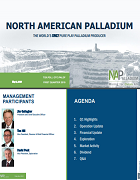The LDI mine expansion offers production growth with decreasing operating costs and expanding operating margins.
Location
The Lac des Iles mine property is located approximately 90 km northwest of Thunder Bay, Ontario in Canada. Access to the site is provided by a year-round gravel access road that connects to a paved provincial highway.
Geology & Mineralization
The Lac des Iles mine area is underlain by mafic to ultramafic rocks of the Archean Lac des Iles Intrusive Complex (LDI-IC). The LDI-IC is the largest of a series of mafic and ultramafic intrusions that occur along the boundary of the Wabigoon-Quetico Subprovince and collectively define a 30 km in diameter circular pattern. The Lac des Iles mine lies in the southern portion of the LDI-IC, in a roughly elliptical intrusive package measuring 3 km long by 1.5 km wide, referred to as the Mine Block Intrusive (MBI). The MBI hosts a number of platinum group element (PGE) deposits; the most defined of these are the Roby Zone and the Offset Zone.
Production History
The Lac des Iles mine commenced production as an open pit in 1993 and expanded underground in 2006 mining the underground Roby Zone. In late 2010, the Company commenced an expansion of the underground mine to access the Offset Zone, and to transition operations from ramp haulage to shaft haulage. Mining from the Offset Zone commenced in late 2012 (via ramp haulage), and is expected to be transitioned to shaft-haulage in early Q4, 2013. Through the utilization of the shaft, operations are expected to benefit from increased underground mining rates and decreased operating costs, transforming the Lac des Iles mine into a low cost producer with a rising production profile.
Mining Method
The current mining method at the Lac des Iles mine is longhole stoping with cemented rock fill (using a primary and secondary stoping block sequence). This method provides the optimal level of flexibility within an overall extraction concept and allows modifications to the panel sizes, as needed to best suit the deposit.
Milling Operations
To conserve energy, the Lac des Iles mill is currently running on an intermittent operating schedule, operating on 14-day campaigns at approximately 13,000 tonnes per day followed by 14 days off. The mill design capacity is 15,000 tonnes per day.
Exploration Upside
Beyond the mine expansion, there are numerous significant exploration targets near the Lac des Iles mine, where a number of recent discoveries could potentially increase palladium production. The positive results from the Company’s drill campaigns underpin the significant exploration potential of NAP’s substantial land package, and supports management’s belief that mining will continue at LDI for many years to come. The exploration potential is further complimented by the existing surface and underground infrastructure, and the mill’s excess capacity. Accordingly, as an established PGM producer with a clearly defined strategy for growth, NAP is well positioned to convert exploration success into production and cash flow on an accelerated timeline.
Environment
Annual monitoring for physical and chemical stability of water surrounding the property is ongoing and will be continued years after the mine has closed. Every three years there is an extensive biological monitoring study that covers an area of 300 km2 around the mine site. This includes the monitoring of fisheries, plants, soils, water, and benthic invertebrates, as well as algae quality and assessment. To date, no negative trends have been associated with the Lac des Iles mine on the surrounding ecosystem. The Lac des Iles mine complies in all material respects with current legislation, and it has all necessary approvals and licenses for the operation of the mine and for all planned expansion projects.
